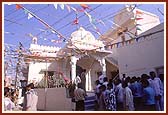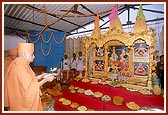| |
CE |
Day |
Event |
Vikram
Samvat |
Month |
Tithi |
| |
|
||
15 January || |
|
|
|
| 1776 |
Wednesday |
Birth of
Nishkulanand Swami at Shekhpat
|
1822 |
Mahã |
sud 5 |
| 2005 |
Saturday |
Murti-pratishtha
at Odhav
|
2061 |
Posh |
sud 6 |
| |
|
|
|
|
|
| |
|
||
16 January || |
|
|
|
| 1820 |
Sunday |
Vachanamrut Gadhada
I-38
Shriji Maharaj says, “One whose mind entertains thoughts of
God but not thoughts relating to the world should be considered
eminent in our Satsang fellowship. Conversely, those who do not
do this, are inferior.
“Furthermore, a householder should engage in worldly activities
physically, but mentally – just like the renunciant –
he should also remain free of worldly desires and should contemplate
on God.”
|
1876 |
Mahã |
sud 1 |
| 1826 |
Monday |
Vachanamrut Vartal-9
Comparing the eternal divine bliss of God with the perishable material
pleasures, Shriji Maharaj says, “When one attains samadhi
of that form, then even if one experiences it for only a moment,
the person who is engaged in worship feels, ‘I’ve enjoyed
the bliss of God in samadhi for thousands of years.’ This
is how one experiences the nirgun bliss of God’s form. On
the other hand, even if one indulges in mayik pleasures for a long
time, ultimately one feels as if it was momentary. Therefore, the
nirgun bliss of God is eternal and imperishable, whereas the mayik
pleasures are perishable.”
|
1882 |
Posh |
Sud 8 |
| 2002 |
Wednesday |
Murti-pratishtha at Tralsa |
2058 |
Posh |
sud 3 |
| 2005 |
Sunday |
Murti-pratishtha at Shela |
2061 |
Posh |
sud 7 |
| 2005 |
Sunday |
Murti-pratishtha
at Memnagar |
2061 |
Posh |
sud 7 |
| |
|
|
|
|
|
| |
|
||
17 January || |
|
|
|
| 1824 |
Saturday |
Vachanamrut Gadhada
II-45
Describing the consequences of pleasing and displeasing God and
His holy Sadhu, Shriji Maharaj says, “If one performs some
karma which displeases the Sant of God or an avatar of God, one
will suffer miseries similar to those of Yampuri in this very body
here in Mrutyulok. On the other hand, if one performs a karma by
which God and His Bhakta are pleased, then, in this very body, one
will enjoy bliss similar to that of attaining the highest state
of enlightenment.”
|
1880 |
Posh |
vad 1 |
| 2001 |
Wednesday |
Murti-pratishtha at Sajpur |
2057 |
Posh |
vad 9 |
| 2005 |
Monday |
Murti-pratishtha at Dholera |
2061 |
Posh |
sud 9 |
| |
|
|
|
|
|
| |
|
||
18 January || |
|
|
|
| 1820 |
Tuesday |
Vachanamrut Gadhada
I-39
Shriji Maharaj explains, “There are two different states of
those who have become muktas by worshipping God. For example, a
person standing atop Mount Meru sees everything in the vicinity
of Meru distinctly – the other mountains, trees, as well as
the ground that supports the mountains and the trees. Similarly,
those enlightened muktas who have attained savikalp samadhi see
jivas, ishwars, maya, and their supporter, Brahma, as being distinct
from each other. A person standing atop Mount Lokalok, however,
sees everything in the vicinity of Mount Lokalok – the other
mountains and trees, etc. – as being one with the ground,
but he does not see them as being distinct. Similarly, those great
muktas who have attained nirvikalp samadhi see jivas, ishwars and
maya as being one with Brahma – but they do not see them as
distinct entities.”
|
1876 |
Mahã |
sud 3 |
| 1932 |
Monday |
Foundation-stone laid for BAPS mandir at Gondal
by Brahmaswarup Shastriji Maharaj
|
1988 |
Posh |
sud 10 |
| 1974 |
Wednesday |
Murti-pratishtha at Limbdi |
2030 |
Posh |
vad 11 |
| 1984 |
Saturday |
Murti-pratishtha at Dabhan |
2040 |
Posh |
sud 15 |
| 2000 |
Wednesday |
 Murti-pratishtha
at Kanisa Murti-pratishtha
at Kanisa |
2056 |
Posh |
sud 12 |
| 2003 |
Saturday |
 Murti-pratishtha
at Vikroli (E) Murti-pratishtha
at Vikroli (E) |
2059 |
Posh |
sud 15 |
| |
|
|
|
|
|
| |
|
||
19 January || |
|
|
|
| 1820 |
Wednesday |
Vachanamrut Gadhada
I-40
Describing the difference between bhakti and upasana, “To
worship God in these nine ways is known as bhakti.
“Upasana can be defined as having a firm conviction that God
eternally possesses a form. Even if a person becomes brahmarup,
that conviction would never disappear. Moreover, even if he happens
to listen to scriptures propounding the view that God is formless,
he would still understand God to always have a form. Regardless
of what is mentioned in the scriptures, he would only propound that
God has a form, never allowing his own upasana to be refuted. One
who has such a firm understanding is considered to possess upasana.”
|
1876 |
Mahã |
sud 4 |
| |
Thursday |
Vachanamrut Vartal-10
Shriji Maharaj guides, “When God is not manifest on this earth,
one should seek the refuge of the Sant who has the realisation of
God – because the jiva can also attain liberation through
him. When even such a Sant is not present, one should keep firm
faith in God’s murti and perform bhakti while observing swadharma
– because doing so can also grant liberation to the jiva.”
|
1882 |
Posh |
sud 11 |
| 1829 |
Monday |
Vachanamrut Gadhada
III-30
Shriji Maharaj describes two things which he absolutely likes, “First,
I like one who is firmly convinced that there is a mass of divine
light which is chaitanya, and that the form of Shri Purushottam
Bhagwan forever resides at the centre of that mass of light; and
with that belief, he worships and offers bhakti to that God. On
the other hand, I do not like one who believes in and worships only
the chaitanya divine light; nor do I like one who does not believe
God to forever possess a form; nor do I like one who does not worship
God. Secondly, I like one who endeavours in austerities, yoga, vairagya,
developing an aversion towards the panchvishays, etc., in order
to please God – without any form of pretentiousness. Seeing
such a person, my mind becomes pleased, and I feel, ‘He should
be congratulated for behaving in that manner.’
|
1885 |
Posh |
sud 15 |
| 1995 |
Thursday |
Murti-pratishtha at Juna Navda |
2051 |
Posh |
vad 3 |
| 2004 |
Monday |
Murti-pratishtha at Samadhiyala-2 |
2060 |
Posh |
vad 12 |
| 2004 |
Monday |
Murti-pratishtha at Mira Road |
2060 |
Posh |
vad 12 |
| 2004 |
Monday |
Murti-pratishtha at Vasai |
2060 |
Posh |
vad 12 |
| |
|
|
|
|
|
| |
|
||
20 January || |
|
|
|
| 1810 |
Saturday
|
Mulji Sharma initiated into sadhu-fold.
Named Gunatitanand Swami
|
1866 |
Posh |
sud 15 |
| 1820 |
Thursday |
Vachanamrut Gadhada
I-41
Shriji Maharaj describes the whole process of cosmic creation, “At
the time of creation, Purushottam Bhagwan – who transcends
even Akshar – inspires Akshar. As a result, Purush manifests
from Akshar. After entering Akshar, Purushottam enters Purush, and
in the form of Purush, inspires Prakruti. In this way, as Purushottam
successively entered the various entities, the activities of creation
took place. Thereafter, Pradhan-Purushes were produced from Prakruti-Purush.
From Pradhan-Purush, mahattattva was produced. From mahattattva,
the three types of ahamkar were produced. From ahamkar, the bhuts,
the vishays, the indriyas, the antahkarans and their presiding deities
were produced. From those, Virat-Purush was produced. From the lotus
extending from his naval, Brahma was produced. From that Brahma,
Marichi and other prajapatis were produced. From them, Kashyap and
other prajapatis were produced. From them, Indra and other deities,
the demons, and all of the mobile and immobile creation were produced.” |
1876 |
Mahã |
sud 5 |
| 1994 |
Thursday |
Murti-pratishtha at Vijayvada |
2050 |
Posh |
vad 8 |
| 1998 |
Tuesday |
Murti-pratishtha at Patana |
2054 |
Posh |
vad 7 |
| |
|
|
|
|
|
| |
|
||
21 January || |
|
|
|
| 1820 |
Friday
|
Vachanamrut Gadhada
I-42
Shriji Maharaj warns, “No matter how great one may be, worldly
influence only leads to harm. Conversely, regardless of how grave
a sinner a person may be, if he maintains profound association with
God – who is satya – then that person also becomes absolutely
pure and attains liberation.”
|
1876 |
Mahã |
sud 6 |
| 1827 |
Wednesday |
Jhinabhai of Panchala passes away to
Akshardham
|
1883 |
Mahã |
vad 10 |
| 2001 |
Sunday |
Murti-pratishtha at Baldana |
2057 |
Posh |
vad 12 |
| |
|
|
|
|
|
| |
|
|
|
|
|
|
|




